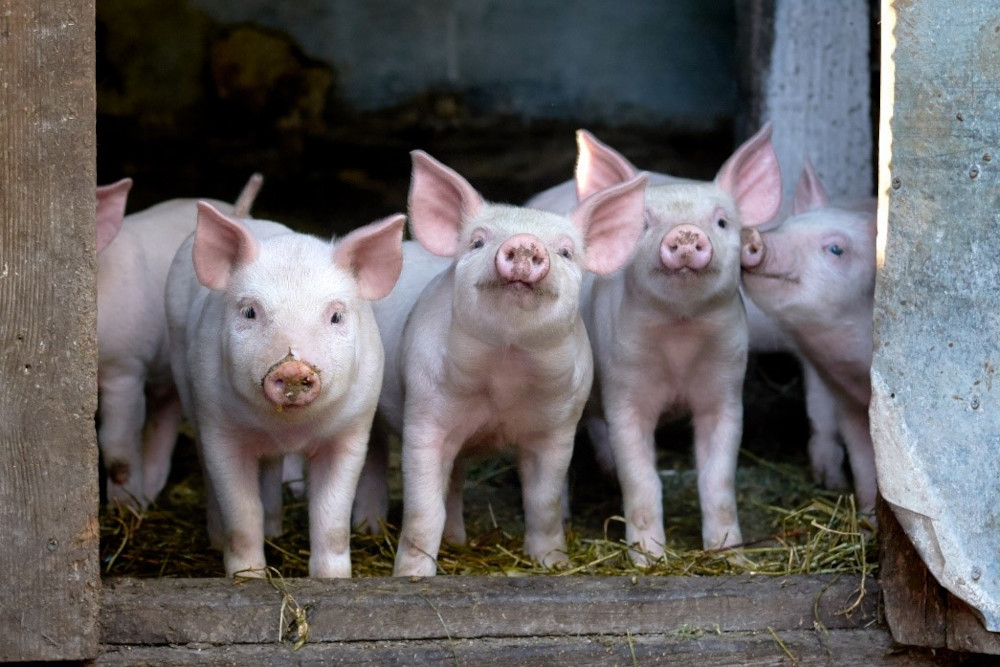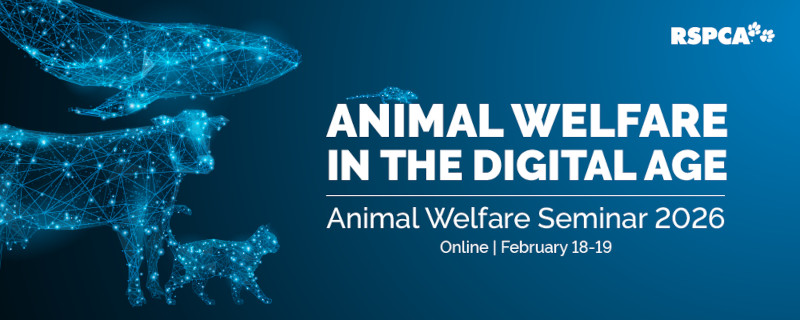
RSPCA defines a painful farm animal husbandry procedure as any action that alters or removes a specific body part of a farm animal and causes pain, suffering or distress. Any procedure that results in tissue injury should be assumed to cause pain, and therefore must be approached accordingly. RSPCA acknowledges that painful husbandry procedures are routinely carried out across many farming systems. However, the aim for all future farming systems must be to identify and adopt humane husbandry and management practices that do not cause pain, suffering or distress to animals. In the interim, best practice pain relief must be used.
Routine husbandry procedures
Invasive and painful procedures that are performed within the pig industry include castration, nose ringing, tail docking and teeth clipping. These procedures can elicit pain and inflammatory responses in pigs [1]. Signs of pain in pigs include increased and prolonged vocalisation, trembling and huddling, stiffness and reluctance to move, tail flicking, reduced nursing and/or feed intake, and withdrawing from other pigs [2].
Prior to performing a painful procedure on farm, proper consideration must be given to the following:
- Removal: If the procedure is not justified, stop using the procedure
- Alternatives: Replace the procedure with a painless or less painful alternative
- Breeding/genetics: Where possible, rear animals that no longer require the use of such procedures (i.e., select for positive welfare traits when breeding)
- Modify: Improve the procedure in order to minimise pain intensity and/or duration
- Treatment: Pain amelioration or prevention using anaesthesia and analgesia [3, 4]
Castration
Surgical castration involves physically removing the testes by cutting them out. If performed, surgical castration is performed during the first week of a piglet’s life to prevent the development of aggressive and sexual behaviours and the occurrence of boar taint (offensive taste and smell evident in pork products caused by the hormone androstenone). In Australia, although piglets are not routinely castrated through surgical castration, it is permitted and there is currently no legislation for the use of pain relief; whereas in the UK it is prohibited due to the pain it is considered to cause [5].
Several alternatives to surgical castration are available. In Australia and New Zealand, slaughtering intact males at a low body weight, before they reach sexual maturity, is one option for avoiding boar taint [6]. Non-physical castration methods (e.g., immunocastration) are commercially available and are effective in reducing the risk of boar taint for pigs that are to be slaughtered upon or after reaching sexual maturity, as such, where castration is considered necessary, immunocastration must be used.
Teeth clipping
Piglets are born with canines commonly referred to as ‘needle’ teeth. Teeth clipping is a practice which involves cutting the tip off these teeth to prevent tail biting and other potential injuries to litter mates and the sow’s udder. Teeth clipping is routinely done in Australia without pain relief. The procedure also requires piglets to be individually restrained which is stressful and after teeth clipping, piglets show obvious signs of distress and pain, such as squealing and ‘chomping’. It can also cause gum and tongue injuries, painful inflammation and teeth abscesses [7].
Tail docking
Piglets have their tails docked (shortened) by cutting the end section of the tail to prevent tail biting of litter mates and other pigs after weaning. Tail biting on commercial farms has led to the widespread adoption of teeth clipping and tail docking as routine husbandry procedures that are perform on piglets within their first week of life. Tail biting is an abnormal behaviour where pigs bite and chew on other pigs’ tails, which can lead to the victim pig being injured and experiencing pain. This is often exacerbated in an outbreak situation, where the behaviour can spread rapidly throughout a group of pigs and victims can be targeted persistently. Multiple factors may lead to tail biting, but one of the main contributors is a barren environment and the inability for pigs to perform their natural behaviours. Risks for tail biting behaviour include an absence of straw bedding and enrichment, low space allowance, poor shed ventilation, inadequate or sudden changes in diet, competition for resources, poor health status, and stress. To reduce tail biting, pigs should be provided appropriate stimulation and satisfies their motivation to explore and forage. Good stockpersonship (positive handling) and a good pig-to-stockperson ratio (allowing close monitoring) are essential to identify changes in pig behaviour for early detection and intervention to prevent a tail biting outbreak. Tail biting has also been associated with a variety of conditions including spinal abscesses, septicaemia (blood poisoning), and a reduced growth rate in victim pigs.
Tail docking is routinely done in Australia without pain relief and can causes acute trauma and pain due to the large amount of nerves in piglets’ tails. After tail docking, piglets display clear signs of pain and distress, including attempting to escape and struggle, squeal, tail wag and clamp their tails between their hind legs [7, 8]. Furthermore, piglets that have had their tails docked can be susceptible to infection and increased sensitivity to pain in the end of their tail [5].
Although teeth clipping and tail docking reduce the incidence of tail biting in pigs, they do not completely eliminate the problem because it does not address the underlying causes. In the European Union, tail docking and teeth clipping on a routine basis are prohibited, and there is further legislation limiting its use in countries such as Denmark, Sweden, and Finland [6]. In Australia, the Model Code of Practice for the Welfare of Animals: Pigs suggests that, where these procedures are performed, that teeth clipping should be done within three days after birth and tail docking within seven days after birth [7].
Nose ringing
Nose ringing of outdoor or pasture raised pigs may be performed to prevent rooting behaviour, which can cause damage to paddocks and/or pasture or infrastructure [4, 8]. Rooting, however, is a natural motivated behaviour of pigs, which they perform when exploratory and foraging in their environment [8]. Several different materials have been used including soft wire, manufactured C-clips, or steel rings which are placed in the septum of the nostril; all however have negative welfare effects by reducing a range of functional activities such as grazing, digging of wallows and rooting, as well as increasing behaviours associated with frustration (e.g., straw chewing and digging at soil) and so must not be used [11]. Management techniques such as rotating pigs kept in outdoor areas, providing pigs with alternate materials to forage can assist in reducing degradation.
Ear notching
Ear notching is one of the most common methods utilised on farm for the identification of pigs, particularly future breeding pigs. The procedure involves the use of specialised pliers to punch a V-shaped notch or notches on the outside of a piglet’s ear. The ear and the position of the notch is meant to allow producers to identify what litter a piglet belongs to and the litter number [12]. Like teeth clipping and tail docking, ear notching is performed without anaesthesia or pain relief. After ear notching piglets can attempt to escape, squeal and head shake, all behaviours indicating piglets find the procedure stressful and painful. Unlike other forms of identification, ear notching is not legally required and is instead a voluntary on-farm management choice, whereas, other forms of identification that also cause pain such as ear tagging or tattooing are legally required under the mandatory National Livestock Identification System (NLIS) for pig traceability [13].
What is the RSPCA’s position?
Before performing any painful procedure, proper consideration must be given to alternatives that could eliminate the need for the procedure in the first place. Where it is considered necessary to undertake a painful procedure, it must be done at the earliest possible age. All procedures must be performed by trained, highly skilled and competent operators. Pig and operator health and welfare are of highest priority. Animal handling must always aim to minimise stress of both pig and operators.
Pain relief using appropriate analgesics and/or anaesthetics must be provided. Current best practice pain relief include local anaesthetic in combination with a non-steroidal anti-inflammatory drug [4]. Research priorities should be aimed at progressing alternatives to painful invasive procedures (e.g., breeding for select traits that remove the need for certain procedures to be undertaken, such as selecting against traits that lead to boar taint) as well as urgent development of technologies that provide longer-lasting pain relief. Procedures must be accompanied by local anaesthetic and, where available, prior administration of analgesics and on-going administration of analgesics post-procedure and where signs of pain are evident.
References
[1] Faure M, Paulmier V, Boissy A et al. (2017) A multiparametric approach to discriminate the impacts of different degrees of invasiveness of surgical procedures in sheep. Animal: An International Journal of Animal Bioscience 11(12):2275-2284.
[2] Ison SH, Clutton RE, Di Giminiani P, Rutherford KM (2016) A Review of Pain Assessment in Pigs. Front Vet Sci. Nov 28;3:108.
[3] Levionnois OL, Mormède P (2014) Means of reducing pain in farm animals. Advances in Animal Biosciences 5, doi:10.1017/s2040470014000211.
[4] Stafford KJ, Mellor DJ, Vogel K (2021) Painful husbandry procedures in livestock and poultry. Improving animal welfare: a practical approach.
[5] De Briyne N, Berg C, Blaha T, Temple D (2016) Pig castration: Will the eu manage to ban pig castration by 2018? 2.
[6] Sutherland MA, (2015) Welfare implications of invasive piglet husbandry procedures, methods of alleviation and alternatives: A review. New Zealand Veterinary Journal 63, 52-57.
[7] AVMA (2014) Literature review on the welfare implications of teeth clipping, tail docking and permanent identification of piglets.
[8] Noonan G, Rand J, Priest J et al (1994) Behavioural observations of piglets undergoing tail docking, teeth clipping and ear notching. Animal Behaviour Science 39:203-213.
[9] Sutherland M (2015) Welfare implications of invasive piglet husbandry procedures, methods of alleviation and alternatives: a review. New Zealand Veterinary Journal 63:1,52-57.
[10] Gregory NG, Grandin T (2007) Pigs. 93-112.
[11] Studnitz M, Jensen KH, Jorgensen E (2003) The effect of nose rings on the exploratory behaviour of outdoor gilts exposed to different tests. Applied Animal Behaviour Science 84, 41-57.
[12] AVMA (2014) Literature review on the welfare implications of teeth clipping, tail docking and permanent identification of piglets.
[13] Australian Pork (2018) Fact sheet: pig identification.

